1984 Jeep Cherokee Reimagines the 4x4 for a New Age
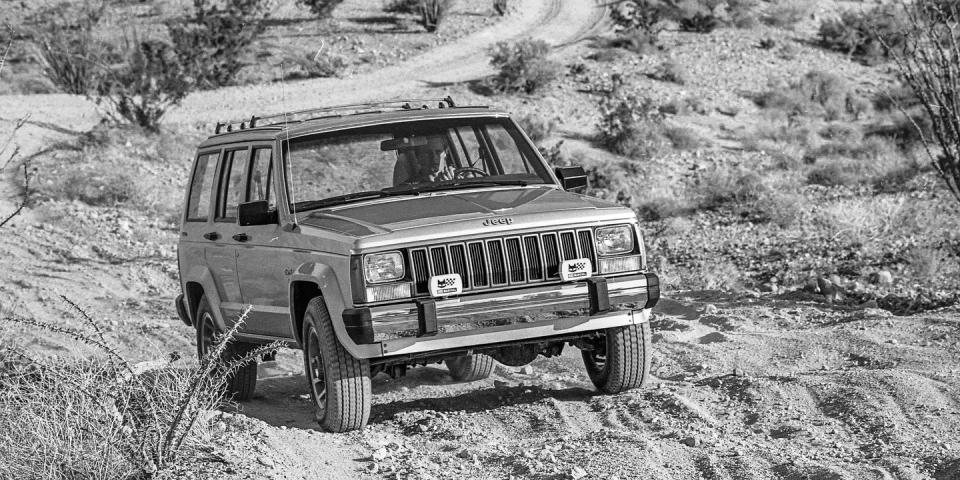
From the September 1983 issue of Car and Driver.
We've been waiting a long time for AMC to get serious. We've always known that it had the moxie to build cars that Detroit could not. Trouble was, AMC always seemed to build things Detroit wouldn't build even if it could. But we've remained patient through the years of Gremlins, Pacers, and Eagles—all thoughtful cars cursed by some inner, triple-distilled weirdness—waiting for better times.
Better times have arrived. We all know what a success the Alliance is, of course, but that's pretty much a Renault deal. The new downsized Jeep Cherokee, on the other hand, is pretty much an AMC deal—and not only is it the first all-new Jeep in twenty years, it's probably the best AMC product in twenty years. When we first laid eyes on the production prototypes, in California's Anza-Borrego Desert, the Cherokee just looked right.
It's a little hard to get your mind wrapped around the Cherokee's mission in life, but Jeep tries to help by calling it "SportWagon." It's a station wagon with extra-functional overtones, an American car in Oshkosh overalls—part car, part truck. It's easy to believe the Cherokee was designed in Kenosha and Toledo, because it harks back to America before the Interstates, when it was tough just to get around. The Cherokee can take you to town in the winter or haul a ski boat in the summer. It has four-wheel drive to bust through the snowdrifts in your driveway or muck through the bog on the way to the summer cabin.
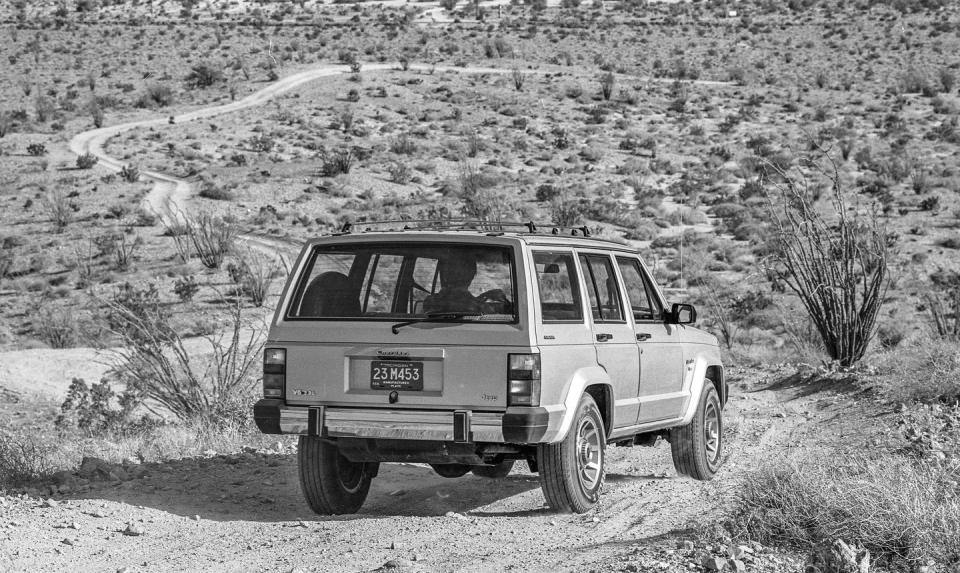
Actually, you can get a grip on the Cherokee by thinking of it as Jeep's version of the S-10 Blazer or the Bronco II. It's shorter, lower, narrower, and 1000 pounds lighter than its predecessor. You'll find either a four-cylinder or a V-6 under the hood, a 4wd system under the body, and all the trimmings of a luxury sedan behind the wheel. This combination in the Bronco and the Blazer has already swelled 4wd sales to unexpected levels and has more than doubled the number of women behind the wheel in this class of vehicle.
The Cherokee is not just a Bronco or a Blazer copy, though. Jeep started with a premise different from Chevrolet's or Ford's, and its result has come out different as a consequence.
To begin with, the Jeep men decided that the new Cherokee's 4wd performance could not be compromised. And, indeed, we barged our way through Coyote Canyon with ease, clambering up boulder-strewn inclines, running through narrow, brush-lined tunnels, then over a stream bed, sluing sideway in the sand for grins, all the while with the air conditioning on max and the Mitsubishi radio at full blast. It's no surprise that the Cherokee should offer Jeep CJ-like performance in its 4wd mode, though, because you'll find two CJ solid axles underneath. Durability is the bottom line in 4wd, according to Jeep, and the best way to guarantee it is to forget about the cost and the complexity of independent suspensions.
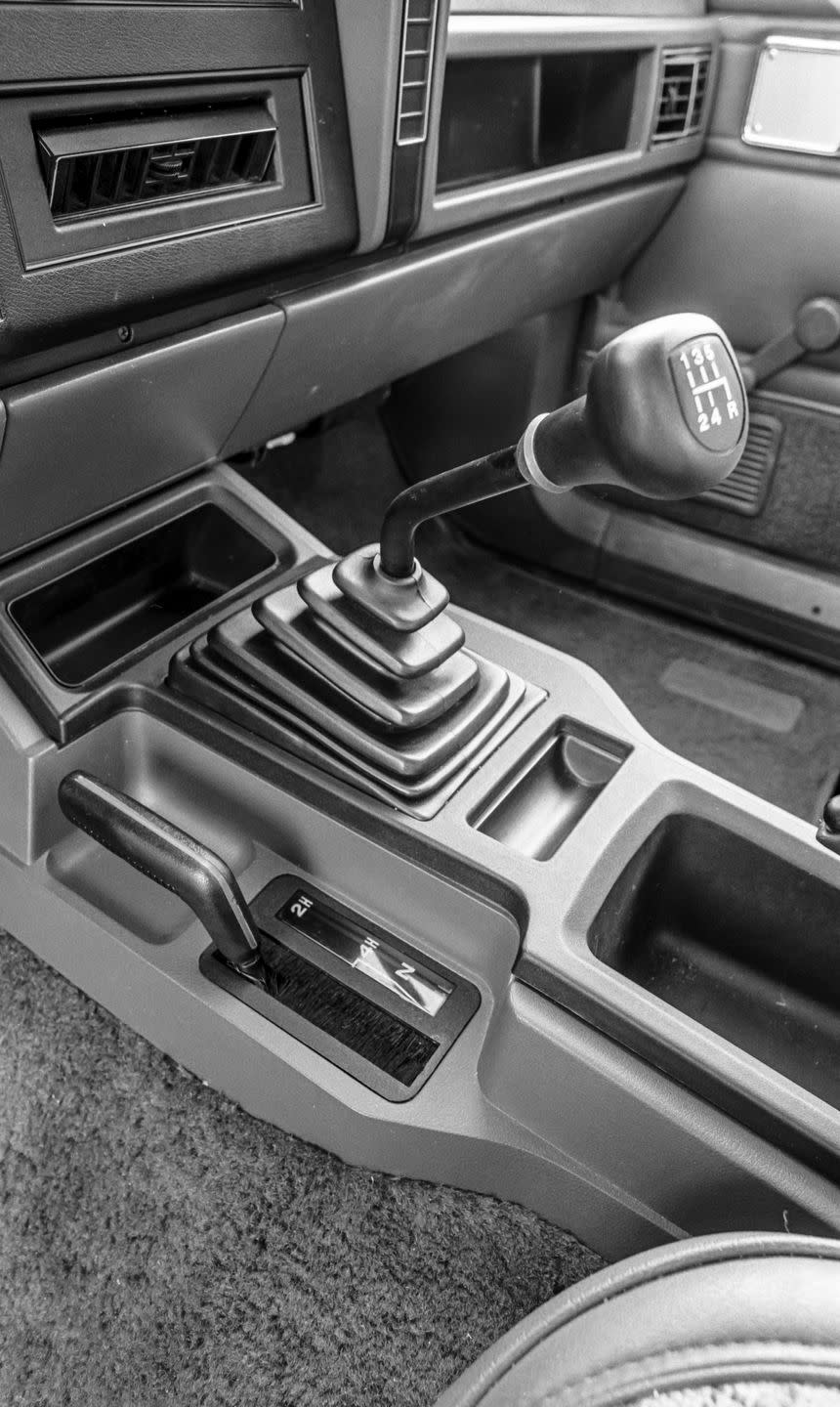
The Cherokee has more going for it in a 4wd comparison with the Blazer and the Bronco than just solid axles, however. There are two 4wd systems available: Command-Trac and Selec-Trac; Command-Trac, like other 4wd systems, offers part-time 4wd that should be used only in low-traction situations. A vacuum-actuated front-axle engagement enables you to switch from rear-wheel drive to four-wheel drive with a simple yank on a handle mounted on the center console; you can forget about fooling around with locking hubs. Selec-Trac also offers both 2wd and 4wd, but it has a viscous-clutch, limited-slip center differential that permits full-time 4wd use on the highway. Both Command-Trac and Selec-Trac are meant to aid traction. According to Dan Hittler, director of powertrain engineering, the notion that full-time 4wd offers gains in fuel efficiency is strictly theoretical. The supposed benefits of such a system are realized only at peak tire loads, Hittler says, and are therefore not relevant to the average citizen's driving style.
AMC claims that its rigid axles provide superior dynamic ground clearance, and this was demonstrated quite effectively over the rock-strewn off-road portion of the press introduction. But what about the 200-mile run over paved mountain switchbacks and flat-out desert two-lanes that were also on the dance card? Francois Castaing, a former Renault Formula 1 engineer and now AMC director of vehicle development, was picked to lead the pack, but solid axles seemed a little low-tech for backroad rat racing.
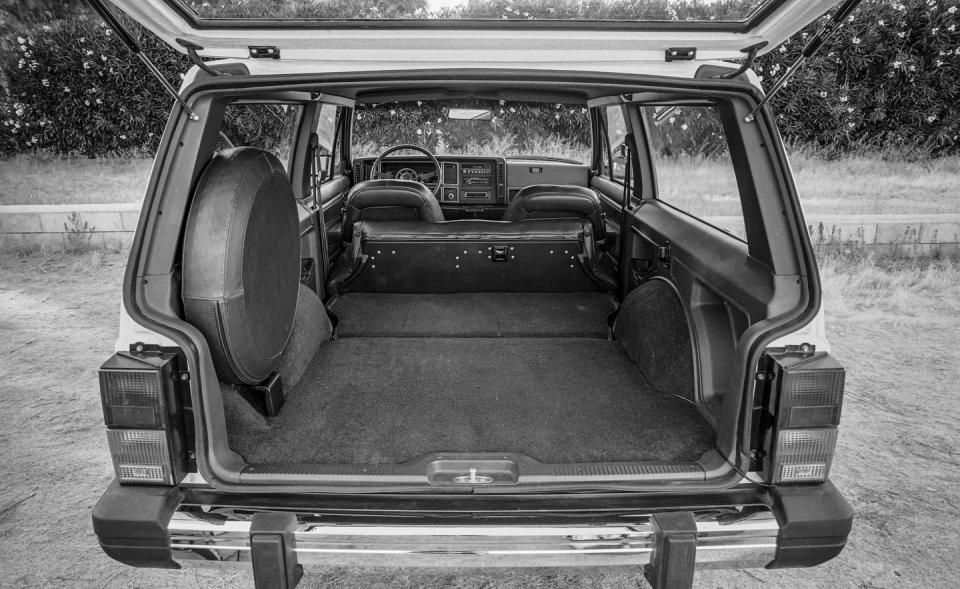
As it turned out, there was no cause for alarm. You can fling the Cherokee at switchbacks and keep all four tires on the ground. It's tight and responsive, and it cuts smartly for the apexes; it's flawed only by slow and extraordinarily numb steering. On the Interstate, the Cherokee feels more stable than a Blazer or a Bronco, and the driver is effectively isolated from the small road imperfections that most 4wd vehicles communicate directly to your fillings. On a flat-out run through the desert, the Cherokee bobbed along happily, the suspension both resilient and able to soak up 80-mph charges through the vados of the Anza-Borrego.
Typically, AMC makes up the theoretical difference in ride and handling between independent and solid-axle suspension with plain old hard work. The front axle is mounted with a standard five-link locating system (four trailing links and one Panhard rod), and the suspension works through coil springs, an anti-roll bar, and low-pressure gas shock absorbers. Coil springs for the rear axle would have intruded into the passenger compartment, according to Jeep, so semi-elliptic leaf springs were used instead. Large spring eyes isolate harshness from the body, while an anti-roll bar and gas shocks handle roll stiffness and damping, respectively. Although the system looks deceptively simple, detail work and tricks with the front driveshaft angle and the steering geometry have largely eliminated the pitch and roll we've come to expect in vehicles like the Cherokee.
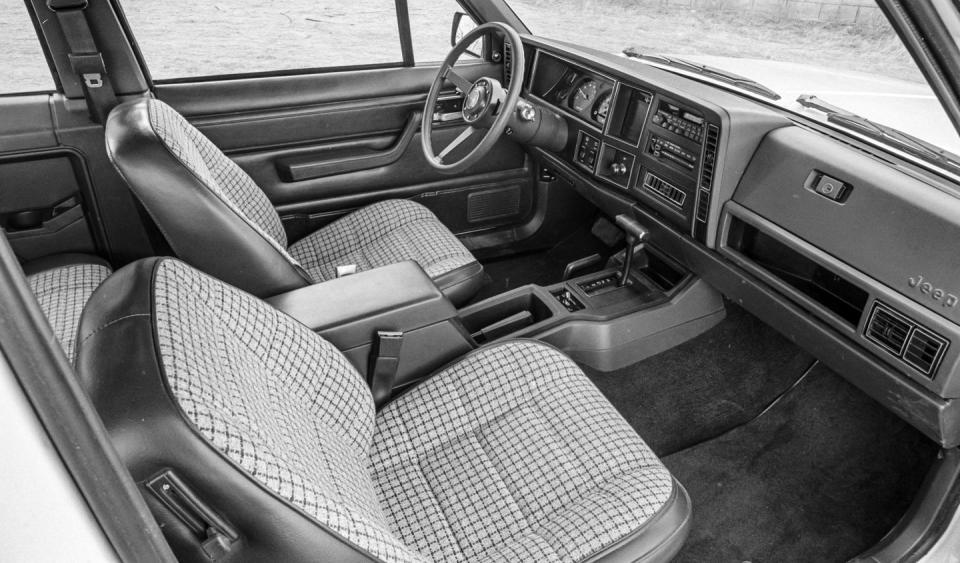
Much of the handling goodness in the Cherokee comes from a fairly rigid chassis. You can pound it through potholes in town or whoops in the desert, and it forges ahead without a shudder. Jeep has integrated a unit body with full-length frame-like members to save weight and provide a rigid mounting for suspension pieces. The result is a chassis that Jeep engineers claim is nearly three times as stiff in torsion as a Blazer's body-on-frame construction.
Under the Cherokee's hood you'll find either a Chevy 2.8-liter V-6 or AMC's new 2.5-liter four-cylinder engine. With 110 horsepower on tap, the Chevy V-6 performs pretty well through either the five-speed manual or the three-speed automatic (with lockup torque converter) transmissions. We didn't expect much from the four-cylinder; after all, the four in the Blazer and the Bronco do little more than process gasoline into noise. As it turns out, though, the AMC four feels bloody wonderful. This 2.5-liter turns out 100 horses and an incredibly flat torque curve. Hook up a four-speed, a five-speed, or an automatic, and you can drive the heck out of it and always feel great. Not only does this engine provide better performance than either the Chevrolet or Ford fours, but it gets better fuel economy, too (according to preliminary EPA estimates).
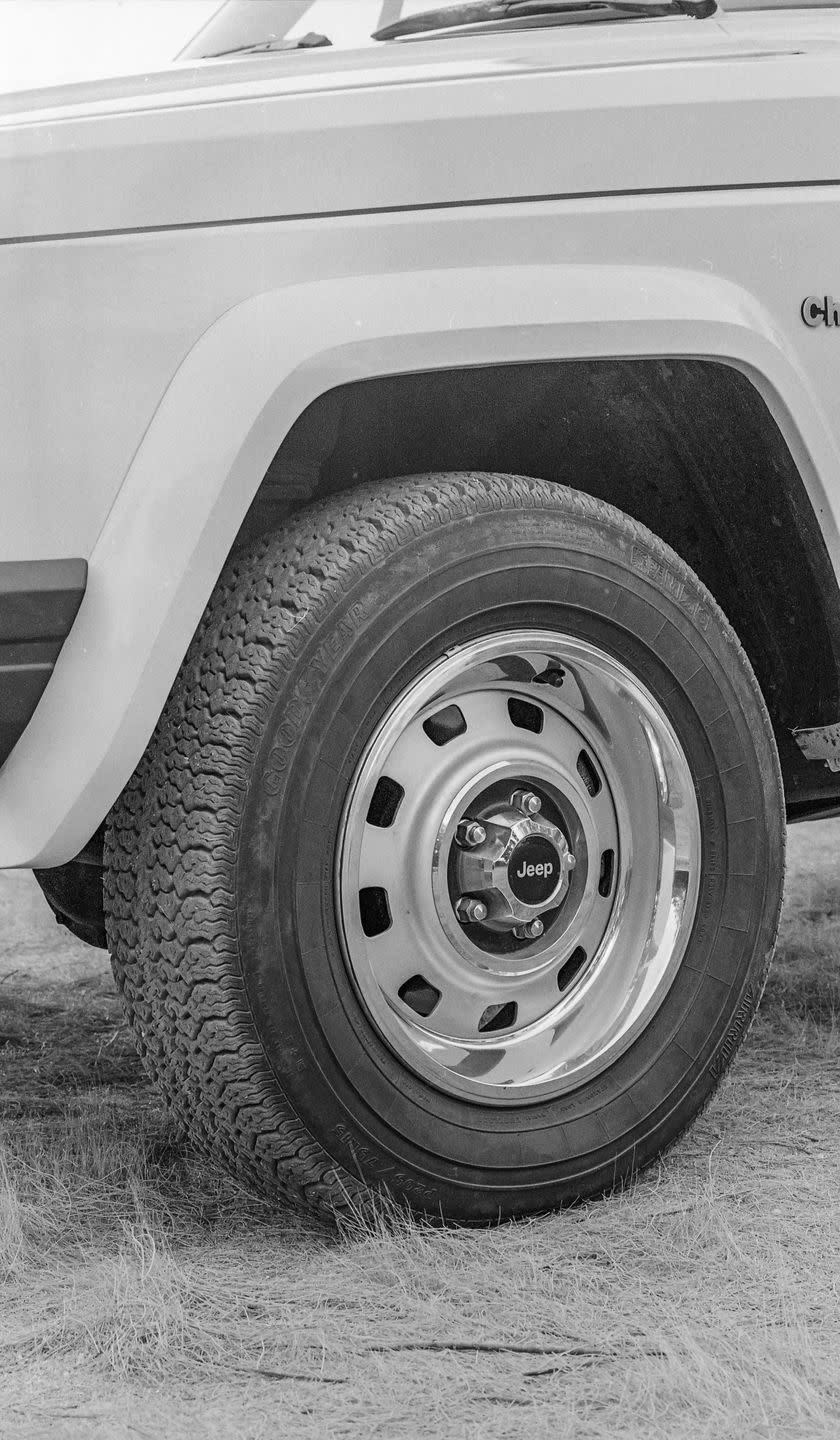
Although AMC used the tooling from its venerable in-line six-cylinder for the new four, the smaller engine has little in common with the six other than bore centers and some lightweight casting techniques. Computer-aided design cut ten months from the penciling of the new engine, and thoughtful engineering took care of the rest. It's an over-square, high-compression design, with big valves and a swirl-type combustion chamber. AMC engineers worked diligently on the engine's breathing as well, which is reflected in the port shape, the large monolithic-type catalyst, and the two-and-a-quarter-inch-diameter exhaust tubing. There's also some trickery in the engine's electronic controls. AMC developed a new knock sensor that can retard the ignition of each cylinder individually, a feat that boosts low-rpm torque substantially. Furthermore, this four has been built as a truck engine, with as much as twice the claimed durability of other domestic fours. The new four and the Chevy V-6 are the first AMC engines to be tested on the new 1000-hour durability schedule introduced by Renault (a 250-hour schedule is standard for most domestic engines).
At this point in a test of an AMC product, we usually have to apologize for its funky looks. Not this time. The Cherokee's cool, crisp lines recall the Range Rover in the way they blend style with the look of utility, each theme complementing the other. Such traditional Jeep licks such as the vertical grille, the squared-off wheel arches, and the general boxiness have been effectively subdued, and yet the Cherokee still has a gritty feeling of character that is missing from the prettified S-10 Blazer and Bronco II truckettes.
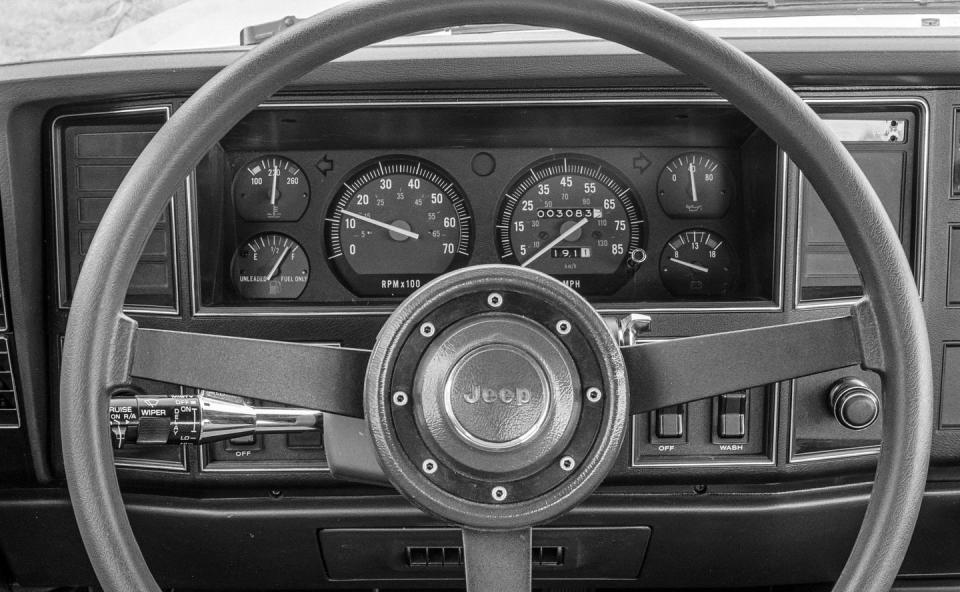
When it comes to creature comforts, the Cherokee is more than competitive with the Blazer and the Bronco. It has the longest wheelbase in its class, which means the rear seat can be situated ahead of the rear wheels, permitting three people to sit behind the flight deck. It also means that both the two-door and the four-door offer better rear-seat ingress and egress than the competition. The rear seat can be folded down to furnish a flat cargo area, which is accessible through the one-piece fiberglass liftgate, or it can be removed entirely.
Up front, the dash is attractive, the ventilation controls are unified into a workable layout, and the instruments (including a tach) are legible. The seats are molded into a shape derived from Alliance seats, and the seatbelt is supportive and comfortable. The only residual funkiness lies in the seat upholstery and the steering-wheel hub.
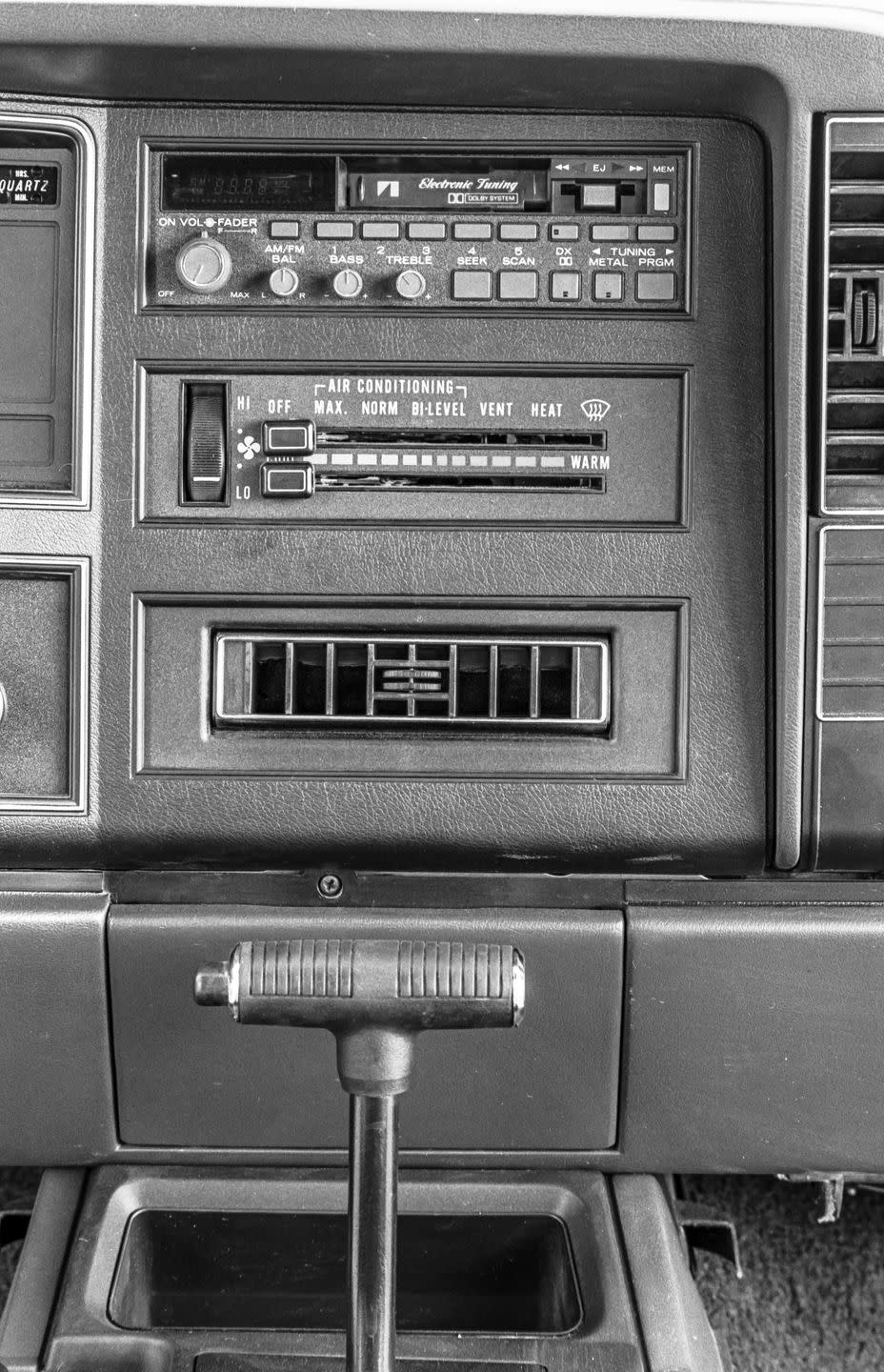
Virtually everything about the Cherokee shows a genuine attempt to bring new standards of comfort and performance to this strange class of utility vehicles. Jeep might be the last to unleash its entry into this market, but the caliber of the hardware and the variety of permutations should make its Cherokee a strong contender. The body is available in four exterior trim levels: base, sensible Pioneer, flashy Chief, and, of course, Wagoneer, which is complete with white sidewalls and optional wood-grain exterior trim. There are three interior trim levels: base, Cherokee, and full-power-option Wagoneer. Then there are the two engines and the three transmissions (the four-speed is available with the four-cylinder only). And don't forget the two 4wd systems—Command-Trac and Selec-Trac—and the two- and four-door body styles. To maintain continuity with heavyweight days gone by, an $18,000 Grand Wagoneer has been carried over with V-8 power.
There are a bunch of choices here, most of them good. The subdued Pioneer trim strikes us as best, and we wouldn't mind having both a two-door with a four-cylinder and a five-speed and a four-door with a V-6 and an automatic. And if you're going to have 4wd, you ought to have highway capability, so Selec-Trac seems best. Cherokees with fours seem more responsive, if slightly less speedy, than those with V-6s, and they steer better, too. The four-doors understeer more than the two-doors, as the four-cylinder takes about 35 pounds off the front wheels.
Chevrolet, Ford, and Jeep all deserve credit for bringing 4wd vehicles out of the dark ages and making them far more acceptable to citizen drivers. Jeep seems to have considered the possibilities most seriously, though. More than its competitors, Jeep seems to realize that 4wd is not just a cosmetic appliance, no matter how limited its use might be in the life of a vehicle.
Jeep knows that when you need 4wd, you really need it. This appreciation of honest performance, not just the right look, shows throughout the new Cherokee's design. It's been a long time coming, of course, but the Cherokee seems well worth the wait.
You Might Also Like

 Yahoo Autos
Yahoo Autos 